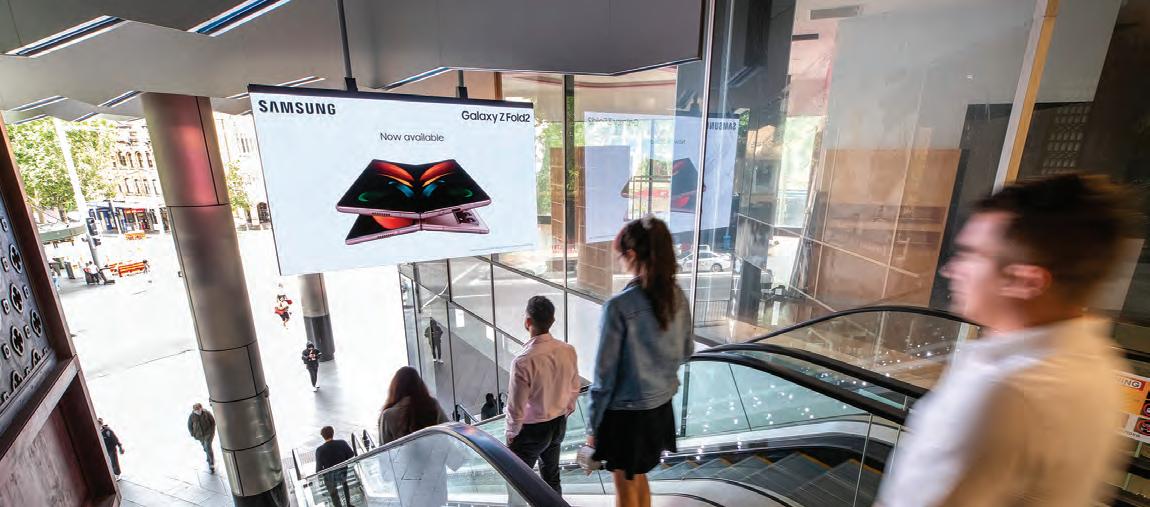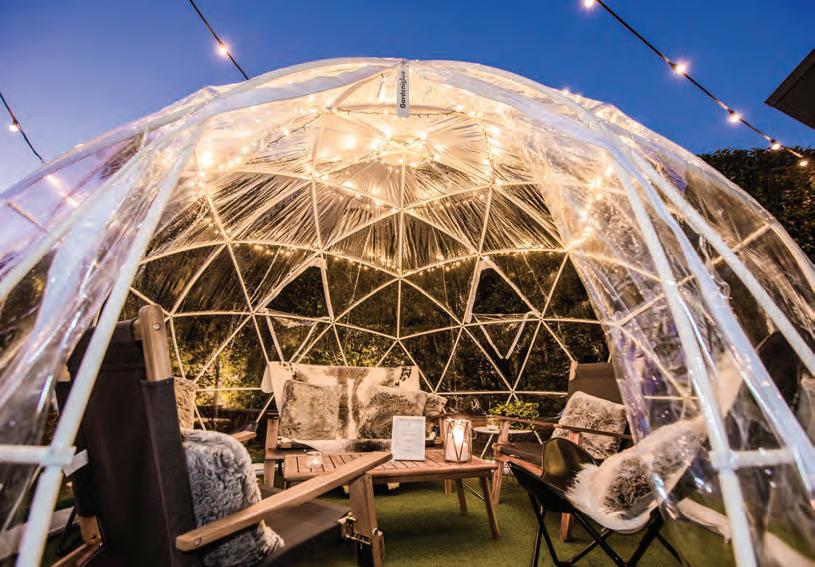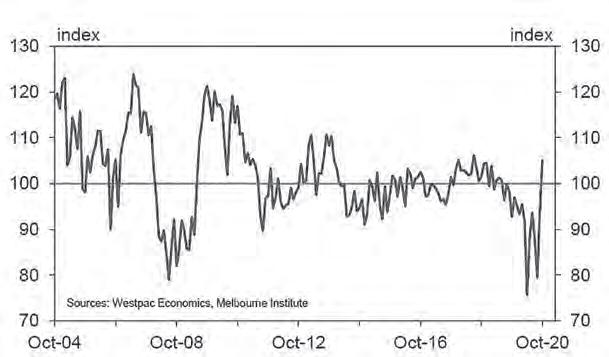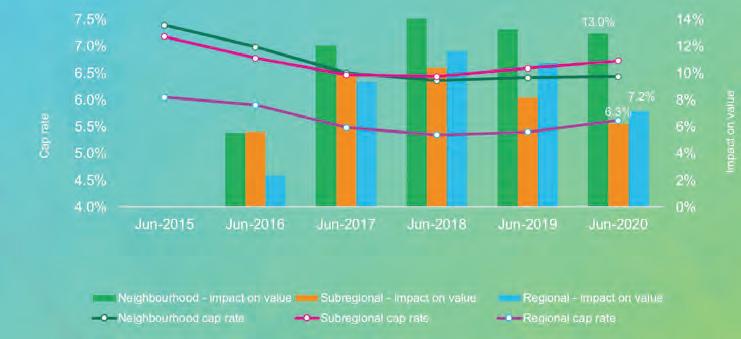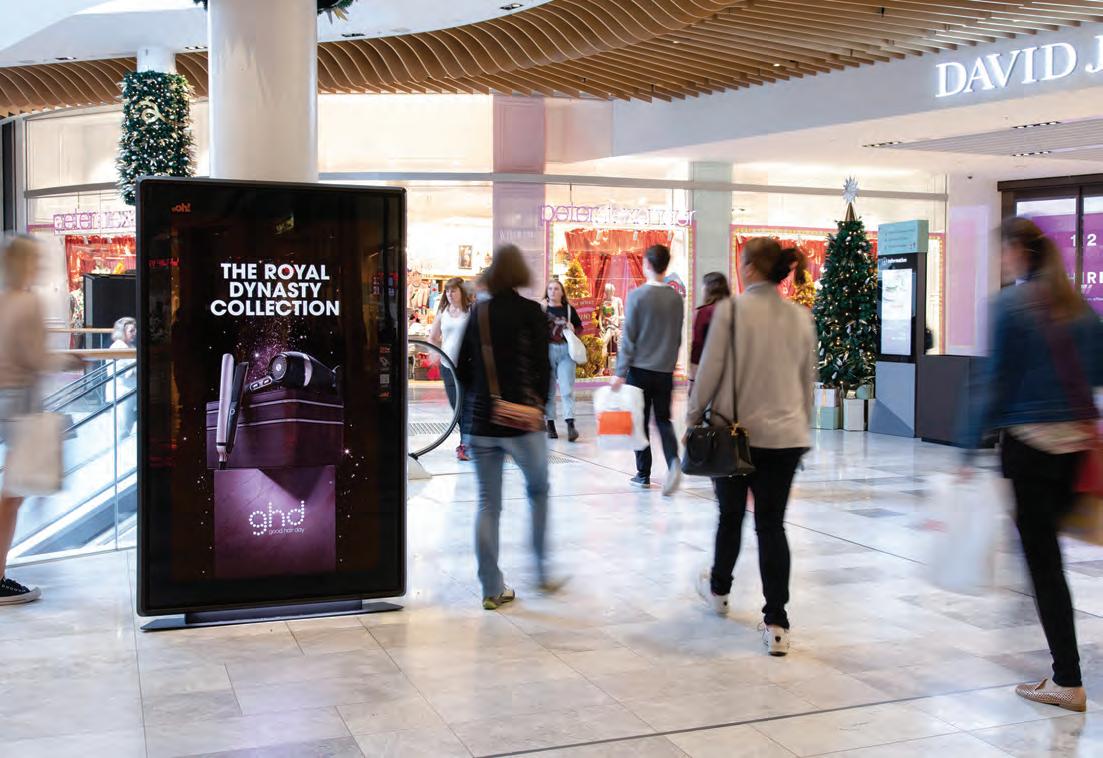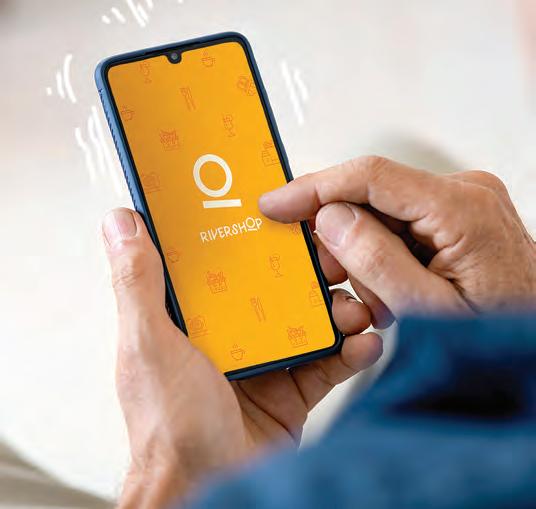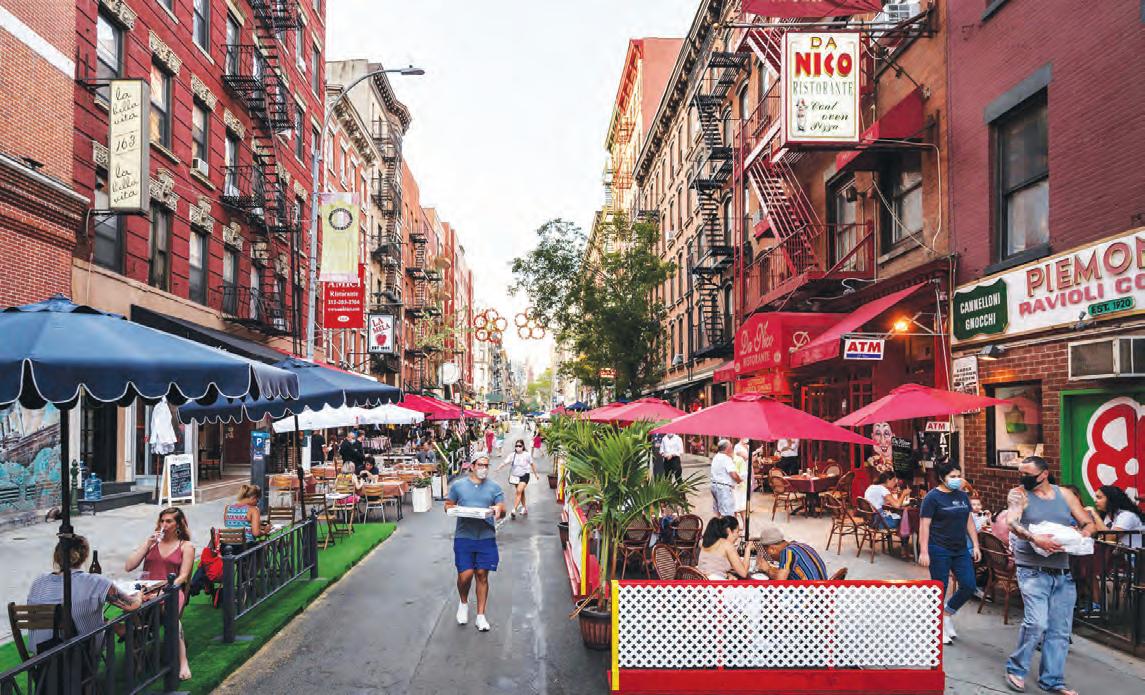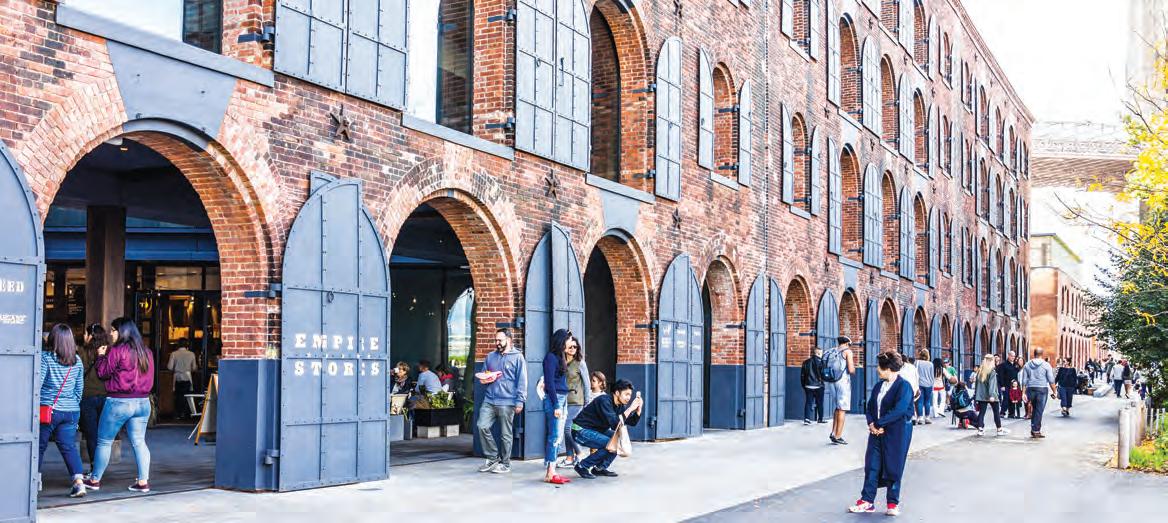
33 minute read
Pop Up News
Scentre Group
Nick Gray, Group Sales Manager, Scentre Group Neil Carrasco, Retail Sales Executive, Scentre Group
Advertisement
Nick Gray is a retail futurist and thought leader who has worked for more than 20 years with innovative brands including Sneakerboy, Nike and adidas. Gray has a rich and diverse set of skills across strategy, omni-channel sales, brand management, marketing and consumer experience.
Neil Carrasco has accumulated almost 30 years’ experience working in the real estate and retail industry as a sales professional and as a franchisee. His first-hand experience as an owner/operator/ marketer enables Carrasco to provide genuine consultation and guidance to BrandSpace partners. Brand building and beyond – new retail categories winning at Pop Up
Pop Up retail is no longer just about moving product – it’s about brand building, customer acquisition and marketing, and that creates a huge amount of opportunity for category growth. While the transactional relationships facilitated by conventional Pop Up activations may be convenient, they are less likely to inspire, educate, and build loyalty. The short-term, fastpaced, high sales volume benefits of Pop Ups are appealing for businesses selling frequent, low-investment purchases. This emphasis on conversion, however, limits the potential of Pop Ups to play a powerful role for higher involvement purchases, such as cars and homes.
These businesses have traditionally relied on their own showrooms and dealerships as destinations for brand building, product display, customer education and engagement. With the acceleration of digital technology and platforms in recent years, consumers now have more information than ever in the palm of their hands, which means they have less of a need to visit these showrooms in person.
For these organisations, shifting their entire marketing effort online is not realistic for such high involvement purchases. Customers still need to physically experience the product. So, if customers won’t come to them, how do business owners bring the showroom to the customer?
Earlier this year, the BrandSpace team worked with Kaplan Homes to launch its first ever Pop Up store in Westfield Parramatta. The idea of bringing the showroom to the customer paid off for this home builder. By having a physical presence in-centre, Kaplan Homes has been able to increase consideration and become a leading expert in the home building space. What Kaplan Homes did particularly well was to recognise that the design of the Pop Up store was an important consideration. Pop Up design should drive interest but also make people feel safe – a set that allows for non-confrontational, self-led discovery is a good start. Having an expert on set, available to respond to and answer questions, also really helps to establish that emotional connection and find true value for both brands and customers.
Having the opportunity to commence an in-person customer relationship from the beginning of the client’s home building journey – rather than digitally or anonymously – meant that Kaplan was able to establish emotional ties in the process and was considered partners, having held the customer’s hand throughout the whole discovery-todelivery journey.
The way that people build connections and relationships with friends and family is the same way we build relationships with brands. People expect to have an emotional two-way relationship, delivering both tangible and intangible moments of satisfaction. People enlist all of their senses to establish whether or not they feel comfortable and to decide whether they want to be a part of something. They want to be enticed and excited by a moment that impresses them enough that they want to share their experience with friends, family and followers.
This gives the physical environment an advantage over online, as explained by Martin Lindstrom, whose multinational study entitled Broad Sensory Branding claims that physical environments provide the “greatest likelihood of
SCN special feature
Kaplan Homes, Westfield Parramatta
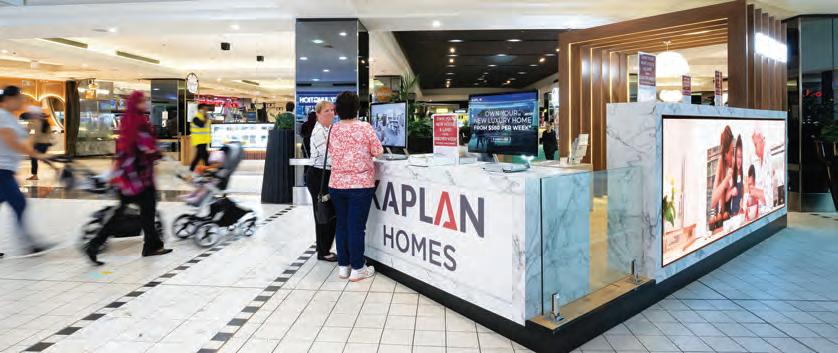
forming emotional connections between consumers and their product”. (Source: Journal of Product and Brand Management, Vol.14. Issue 2).
While online plays an important role in the research phase for products like cars and homes, Pop Up retail can also assist at this point in the customer journey. Extending the physical experience into Pop Up enables brands to attract customers who wouldn’t necessarily make a trip to a showroom, but may come across the activation in their local shopping centre, and feel inclined to take a look.
Attempting to drive growth through online channels only while completely neglecting the offline strategy, results in a trade-off between engagement and effectiveness for scale and efficiency. Scentre Group believes there is a role for both and we need to have a balance, as brands and businesses realise that both online and offline are essential to each other but there isn’t a more manageable, tangible or measurable form of marketing than physical. In other words, forget about where the final purchase takes place – just make sure it does.
Director of Strategic Analytics at Scentre Group, David Lamond and his team have found that there is a correlation between sales occurring online and physical stores.
This was something that Kaplan Homes understood. Kaplan wasn’t just buying space – the company understood that there was a media value to its set and it could attribute spend in the surrounding area back to the Pop Up catchment or ‘halo’ around the set.
It’s worth remembering that you can’t just measure success on the number of people who are ready to purchase. Sell-through is something that usually determines success in the store, however, it’s like trying to determine your overall health based on what you ate for breakfast. It’s so incomplete.
Kaplan Homes is just one of the many non-traditional retail categories that is benefiting from the physical retail channel, using Pop Ups to proactively engage with potential customers in a place where they habitually visit and feel comfortable. More and more ‘showroom-based’ brands are discovering that inherent barriers or misconceptions can be removed and/or changed when a customer has an opportunity to view a brand or product unexpectedly in an environment that feels familiar.
AMP Capital
Courtney Ross, General Manager, Commercial, Retail, AMP Capital
Courtney Ross is responsible for the delivery and execution of commercialisation strategies across all AMP Capital retail assets within the Australia and New Zealand portfolio. In her current role as General Manager, Ross and her team are focused on connecting brands with audiences, delivering experiences designed to engage the customer across the retail portfolio while understanding the commercialisation expectation of all stakeholders to deliver investment returns for the business. Ross joined AMP Capital in 2016 as a Divisional Manager from Scentre Group where she grew her media and retail sales career from 2011. The evolution of retail and the changing face of Pop Up
Chanel Fragrance & Beauty Boutique
Pop Up retail often comes with the historical stigma of short-term activity spanning anywhere from days to weeks and selling weird and wonderful gadgets such as pots and pans and everything in between…
With the client mix evolving now more than ever before, client needs and the various categories of spaces and locations available, in recent years, Pop Up has a far more interesting story to tell. There is a huge drive from all angles – landlord, retailer, client and customer – to shift the market perception of Pop Up retail and demonstrate the endless possibilities and benefits this strategy can provide to all parties.
Towards the end of 2019, there was a willingness from both large and small brands and retailers to trial Pop Up retail, a category and offering that has been around for quite some time within shopping centres – it was finally starting to evolve again. Throughout recent months, this willingness and direction has remained consistent with a portion of online retailers continuing to look towards Pop Up sites to further develop their brand within the market.

Cheep Clothing Store, Indooroopilly Pop Up retail has traditionally been seen as a short-term option to potentially incubate new retail concepts and products, 2020 has seen us all adapt again with Pop Up proving to be a solid option for brands and retailers looking to respond to the current market and quickly.
Experiential and key moments
In response to the current market, some retailers are also considering how curated experiential programs can complement their current business strategy and support in sales driving activity. Landlords remain focused on offering unique products and experiences to customers, to provide a promising pipeline of brands with conversion potential for future leasing conversations. Pop Up retail remains successful, tried and tested strategy to launch first-to-market events, industry leading events and activations. There is a common goal, to enhance
opportunities to surprise and delight

SCN special feature
customers while in-centre. The event held by Grey Goose with the resort precinct in the summer of 19/20 was a perfect example of this. Dubbed the ‘Fountain of Goose’, the installation was decorated with bottles of Grey Goose’s current limited-edition release (a collaboration with Parisian fashion label Maison LaBiche) and was designed to bring a French-style escape to Pacific Fair customers. Grey Goose Pop Up, Pacific Fair In addition to delivering a curated experiential program that’s aligned to a brand's objective, key moments of relevance also exist in our customer’s lives. This presents yet another exciting opportunity to deliver experiences to delight our customers across these moments throughout the year. In the world of Pop Up retail, key elements of collaboration, curation and creativity allow these partnerships to work seamlessly between landlords, retailers, brands and our customers. This year, more so than ever before, Pop Up retail will play a huge part in supporting and adding to the Christmas moment in shopping centres. Not only an opportunity to surprise and delight, but an opportunity to provide something unique, offer a moment of relax and respite or something to make the moment a little easier will be key.
As one of our most valuable client groups, retailers are often looking for ways to amplify their openings,


relocations or in-store marketing campaigns. The benefits of Pop Up retail are becoming more evident, with several existing retailers across our portfolio now exploring this option to promote their business and increase brand awareness. Pop Up opportunities are also becoming increasingly common across both large retail brands and sole traders, as the traditional retail landscape has dramatically changed during the past six months. Pop Up stores provide retailers with the desired level of flexibility at key moments, and the opportunity to retain a standalone physical presence in shopping centres or secure additional footprint in key times. Stop by Macquarie Centre this Christmas to visit the Chanel Fragrance & Beauty Boutique or as in previous years, pop into their Pop Up located adjacent to their boutique.
Pop Up stores
While strong relationships externally are needed to deliver these exceptional experiences in all of our shopping centres, there are a number of internal relationships and partnerships teams need to develop and rely on that are vital in supporting and growing this retail strategy. Throughout the AMPCSC managed portfolio, key to this success is support from our Place & Design teams. The collaboration between teams allows for creative product displays within vacant stores, innovative and adaptable solutions for these stores in very short turnaround times, providing the best solution for Pop Up retailers. These benefits attract retailers who are looking for an established Pop Up site as an entry point into the market. Over the years, we have seen a number of successful Pop Up stores utilise the space creatively to drive foot traffic, build a strong customer base and transition over to a stable lease. There are consistent themes across our most successful stores, where we can clearly see elements of creativity across impactful branding and product displays. We often see the best results across Pop Up retailers who push the boundaries, think outside the box and deliver an experience for customers who enter the space.
Cheep Clothing is one of Australia’s largest private vintage resellers currently in the market. Cheep Clothing is an exciting and relatively new Australian Pop Up shop brand, known for its eccentric pink theme and merchandising, and operates out of both the WA and QLD markets. The company's strategy is simple and attracts crowds upon launch days right through.
There is now more than ever a growing list of brands and new retailers that are unique, exciting and provide a point of difference to shopping centres ready to experiment and launch into the world of retail via Pop Up stores.
Pop Up Retail, Short Term Leasing, CML – whatever we all choose to call it, offers an agile solution for brands and retailers to consider when launching a business, expanding a product line, testing and trailling a new market or providing an experience within the retail environment. We are anticipating this space will become increasingly popular, with brands and retailers leveraging sites across centres to remain agile and nimble, showcase creativity and innovation, setting themselves apart from competitors in the current market.
Lendlease
Sally Harding joined Lendlease in 2011 as a National Key Account Manager for Casual Leasing and was appointed General Manager, Pop Up & Commercialisation 18 months later. Harding is responsible for the delivery of innovative and unique revenue generating activations across physical and digital Pop Up platforms. These include short-term licences for new businesses, semi-permanent retail incubation, commercial alliances, experiential brand activations, promotional sampling, customer acquisitions and multimedia advertising channels. Harding has more than 14 years’ experience in the industry, having worked for Scentre Group and AMP Capital.
The evolution of Pop Up has been rapid and immense. What once existed almost solely to add a little boost to shopping centres’ net operating income and asset valuations has become a critical part of the sector’s future. Lendlease expanded and adopted a new approach to its Pop Up offer six years ago, and continues to grow the opportunity for its communities and clients.
Pop Up expansion
Back in 2014, Lendlease Retail restructured its single channel Casual Mall Leasing to Pop Up Retail. But it wasn’t just a name change – we transformed the service entirely and invested in its expansion.
Adding to our physical Pop Up sites, we launched an in-house media platform with the installation of our first ten screens in 2016, which has now grown to 22 screens across 11 centres. The media platform has delivered double-digit profit growth for Lendlease since its inception.
We also transformed our approach to sales; where we used to sell space in the middle of our malls, we now work closely with clients to understand their business objectives and tailor a bespoke Pop Up program that helps meet their goals, using a combination of physical and digital channels. This has helped us to build relationships with key clients whom trust us to understand their business and meet their needs.
Bangarra Dance Company, Cairns Central
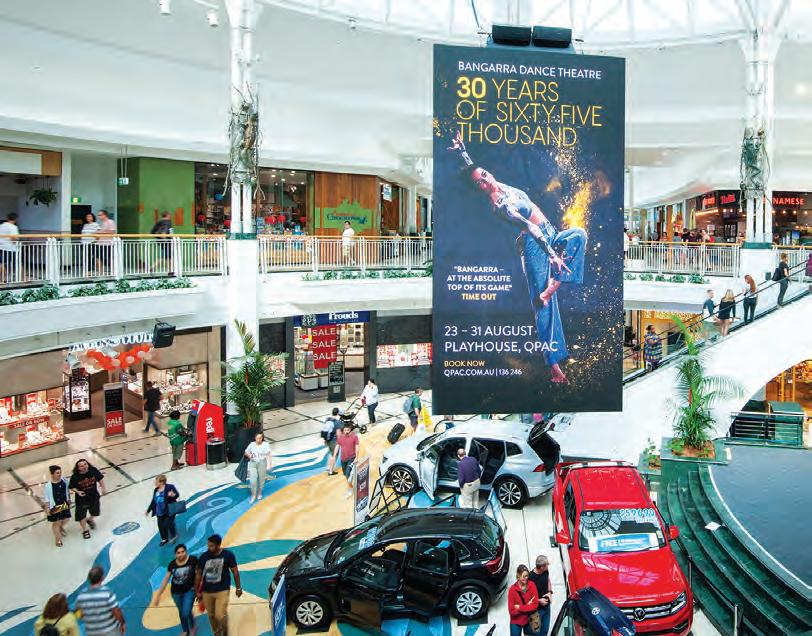
SCN special feature
We also developed a new suite of tools to showcase our services, including launching a new website and range of collateral. To reach new clients, advertisers and partners, we use a number of mostly digital channels, including Instagram, which has become our most powerful networking and lead generation tool.
In the past five years, we’ve serviced more than 2,500 Pop Up retailers and worked with 620 direct clients.
Growth area: pure online players
One of the most exciting growth areas for Pop Ups is supporting pure online players to experiment with bricks-andmortar retailing and, so far, we’ve had some incredible success stories.
For example: high-end children’s toys and eco-friendly products retailer, and purely online retailer, Rockabeez, recently leased a physical Pop Up store at Southlands Boulevard.
Owner, Marco Comina said: “Online is so competitive and advertising overheads are quite big if you want to be seen. With our retail store, we have the foot traffic and more options for people to try our products out of the box; this has helped our sales increase. We have also advertised the physical store on the website and are seeing customers coming to us off the back of that.”
It’s not only Rockabeez – online florist, Cherry Blossom recently tried out a physical store at Lakeside Joondalup.
Owner, Riana Bertolami, said: “My business has increased significantly outside of the social media platform I was using before. Having a physical store has allowed me to create an image and space my customers love. The foot traffic has made the biggest difference
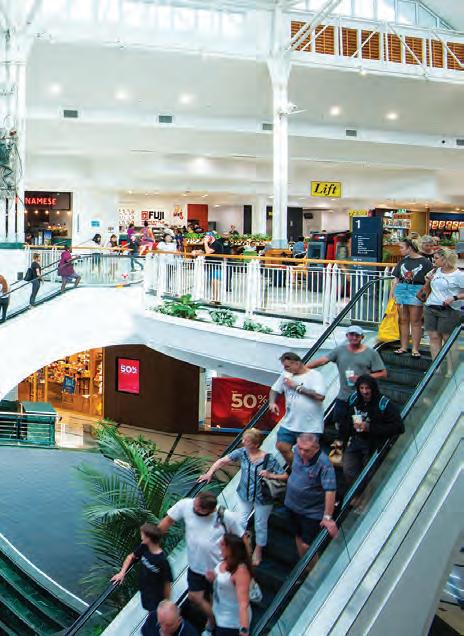
Riana Bertolami, Cherry Blossom

to my turnaround. Having my shop – to be able to do physical displays – has also helped me develop and improve my craft.”
Our success with pure online retailers can be attributed to our focus on ensuring these ‘first timers’ have the best experience possible when they work with us. We mandate same-day responses, create personalised proposals with tailored solutions, offer lots of flexibility and guide them step-by-step through the process of ‘setting up shop’.
In the past two years, we’ve transitioned 57 retailers from pure online platforms to a physical Pop Up site. This is an important growth area for us as we’ve found that, in general, online businesses are at the forefront of innovation, bringing interesting and unique new products and services to the Australian consumer. Most of these retailers are also already digitally savvy, and hyper-aware of their target audience, which helps our team to prepare effective proposals. Supporting our communities
Lendlease continues to strive for greater social and environmental sustainability. That’s why we’ve developed a Pop Up content strategy that’s aimed at not only driving engagement for our paying clients, but also supporting important community causes and organisations across Australia.
Our content strategy has four pillars: Sustainability, Community Support, Safety and our Reconciliation Action Plan. In line with the strategy, we’ve embedded live data feeds into our digital screens network to let shoppers know about Lendlease shopping centres’ water and energy savings.
Working with Lendlease’s EH&S team and centre-based operations managers, we’re broadcasting important safety messages to retailers and customers, which has been critical during the current global pandemic. Earlier this year, during the height of the bushfires on the east coast of Australia, we were able to use our Pop Up channels to drum up vital support for the Rural Fire Service and the Red Cross.
To deliver on Lendlease’s Reconciliation Action Plan, we’ve developed strong partnerships with First Nations enterprises including Mainie, Derwang Art, Bangarra Dance Company and AIME Mentoring.
Through our Pop Up media platform, we’re enabling our partners to broadcast their powerful and important messages to millions of people who visit our shopping centres every day.
We’ve supported our partners with more than $2.2 million of in-kind support during the past three years. On top of that, we’re opening each day of trade across our shopping centres with an acknowledgement of the local traditional owners.
Expanding our suite of assets and connecting more meaningfully with our retailers, shoppers and communities has enabled our platform to thrive. We’re confident that although the retail industry will remain challenged for some time, the Pop Up space still has great potential for growth.
QICGRE
Dennis Michael is Head of Commercial – Brand iQ and New Business for QIC Global Real Estate. In 2019, his contribution to retail transformation was acknowledged with the Frank Lowy Fellowship. Before joining the shopping centre industry in 2015, he worked for prestige media brands including Vogue and GQ. Here, Michael shares a snapshot of the trends and technology shaping temporary retail experiences across 25 QIC Global Real Estate centres.
QICGRE’s Brand iQ division On the road to growth specialises in co-creating, marketing Among the categories to have and measuring Pop Up retail activations boomed in short-term formats across that resonate with our communities our network in recent years are throughout Australia, and the creativity homewares and automotive. The at work in this part of our industry is combination of flexibility and premium propelling us to new levels of customer positioning has suited Artisan Home knowledge and a wider-than-ever array exceptionally well at Eastland, for of leasing solutions. example; the retailer having expanded
During the past five years, we’ve from its original 70m2 six-month seen the concept of the Pop Up evolve tenancy in 2018 to the adjoining retail in this country from a trestle table- spaces with brand extensions Artisan based operation to incorporate full- Grow and Artisan Kids. service, temporary storefronts with Car dealership offshoots such as slick visual merchandising and Subaru Castle Hill’s ‘experience store’ complementary digital footprints. at Castle Towers, meanwhile, have In addition to being an increasingly been enjoying strong sales within an sophisticated and significant facet of environment where shoppers feel at our business, short-term leasing sites ease browsing and buying. The and services are striking a particular chord right now because Robina beauty kiosk they enable businesses to quickly connect with post-lockdown consumers craving new experiences close to home.
Pop Ups are far from a one-size-fits-all component of the tenant mix; agreements range from a single day to six months and we offer everything from casual mall leasing packages with display furniture temporary store’s popularity prompted inclusive to centre court activations Subaru to invest in refurbishments that tour different properties, to small recently as well as host a complementary customisable kiosks to temporary centre court activation. in-line shops in our most prestigious FMCG brands such as Heinz and precincts. The common factor in all of Red Rock Deli continue to use the Pop these is direct conversation: regardless Up format regularly to raise awareness of budget or business objective or about new products, while beauty Pop Up duration, all of our kiosks remain a staple of this market. collaborations come about through Homegrown fashion brands that would one-on-one dialogue between the have traditionally gravitated towards operator and a QICGRE customer outlet centres or store-within-a-store experience specialist. options have also started leveraging

SCN special feature
Grand Central automotive Pop Up

Hyperdome food Pop Up

our Pop Up portfolio to trial new territories and secure bigger bang for their buck.
Education providers, real estate agents and other unconventional Pop Ups such as financial advisory firms are also reaping great rewards in our centres.
Completing the puzzle for pureplay
After inducting a number of digitalnative retailers into the physical realm via Pop Ups, we have bolstered both the information we provide upfront and the mentorship we offer throughout. Today, if someone requests a turnkey retail space for a short period, we have the processes and dedicated personnel in place to facilitate that and assist them in executing a 360-degree retail strategy that syncs online and offline success.
When we collaborated with Runaway The Label on the brand’s first store at Robina Town Centre last year, for instance, we connected the team with trusted local suppliers of staff and retail display solutions, ran a centrewide media campaign to supercharge visitation and installed traffic counters to build out their data insights. Smart mirrors (facilitating virtual try-ons) helped to connect the physical experience to the digital one and the retailer reported significant boosts in both brand awareness and customer sentiment following the Pop Up.
Small business growth is top of mind in QICGRE’s new partnership with a leading ecommerce management platform. The tie-up will connect a new generation of Australian pureplay retailers with Brand iQ Pop Up retail sites throughout the country, enabling platform users who have hit the ceiling of what they can achieve through online sales channels such as Amazon and Catch.com.au to access an entirely new pool of customers. By promoting shopping centres as the preferred physical extension for innovative and emerging brands, we all get closer to realising the true value of omnichannel retail. Design of the times
The aesthetic standard of Pop Ups has soared in recent times. At QICGRE, we are fortunate to have a team of retail design and delivery experts whom understand the unique constraints and opportunities associated with small and shortturnover spaces. We are also highly conscious of limiting the wastage involved, which is partly why we established our collection of ready-touse display furniture. Our experienced leasing and design teams can have you up and running in as little as 24 hours – it isn’t just the digital world that moves quickly.
We are looking beyond the interior walls of our centres, too. Our carparks, rooftops and adjoining green spaces represent a valuable resource in an era of social distancing. In the past, we have hosted six-week circuses outside
Hyperdome and this summer we are running Pop Up parks at our
Victorian properties to support food operators with additional
COVID-safe seating capacity. Going further outside the norm, we also expect to launch more unmanned
Pop Ups in the next 12 months in light of this year’s acceleration of contactless innovation.
Another shift is in the timing of Pop Ups. Whereas we used to see all the activity compressed into the Christmas trading period, more operators are cottoning on to the fact that QICGRE will help them create and harness major promotional events throughout the year. At Brand iQ, we see it as our mission to overcome perceptual barriers around bricks-and-mortar retail, because, in doing so, we can make the Australian shopping centre industry more vibrant as a whole.
Stockland
Lisa King, National Manager – S Connect, Commercial Property, Stockland
Lisa King joined Stockland in 2018 and is responsible for Pop Up, vacant shop, media campaign, experiential, vending and telco commercial outcomes. King has eight years of experience in property and more than 20 years in media and advertising, working with luxury and FMCG brands. Prior to joining Stockland, King was Head of Commercial at Adshel, and previously Head of Brand & Retail Solutions at AMP Capital. She has held senior roles in media and advertising, in media planning/buying, radio, publishing, out-of-home, commercial and retail media. She has been responsible for revenues and teams across Australia, New Zealand and Asia.
This year has certainly been a challenging one in the Pop Up industry, however, it is inspiring to see many new opportunities rise in the wake of these challenges, proving that Pop Up is most definitely alive and well, and even more nimble, creatively executed and customer-centric.
At Stockland, we’ve been working with regional show exhibitors to monetise their excess stock through show-themed activations across our portfolio. Selling ‘you deserve a treat’ show bags and enticing customers to purchase a ticket to their on-site show rides has been welcomed by those who missed out on this annual family event. Furthermore, the many food trucks at the show that provide us with delicious treats – from fairy floss to gozleme and everything in between – have been welcomed in-centre, which has helped to not only support their small businesses, but also surprise and delight our customers, whom feel positive memories and emotions connected to these experiences. This is a strong example of how Stockland continues to create and facilitate convenient and curated experiences for our customers that add value to their lives.
Fashion face masks, home office consumables, home entertaining and other items designed to make the increase in time spent at home more enjoyable, have also been at the fore of Pop Up recently. COVID-19 has seemingly prompted an influx of many new businesses, as those who may have lost their jobs or are simply looking for a change are trying their hands at a career in Pop Up retail.
The flexibility and versatility that Pop Up offers has been a big attraction for small businesses and we’ve welcomed a range of start-ups, from new culinary offers, to beauty offers, ethical clothing and bespoke accessories.
The results so far have been clear cut, with many of these start-ups acknowledging that it has been an advantageous opportunity for them
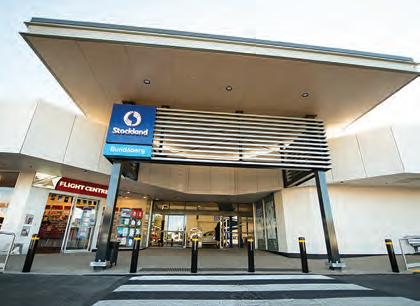
to learn the ropes of retail with minimal financial exposure. The ability to relocate, test and trial their businesses in distinctive trade areas – or extend the number of locations through organic growth – has been a central part of their journey.
Small businesses have helped support retail centre vacancies, and their prosperity has allowed us to backfill those spaces quickly while still placing focus on the retail mix. A new small business – with its compelling presentation and variety – allows it to succeed above expectations, especially in terms of brilliant execution and impact. The marriage of commerce and curation is the perfect win-win for both small business owners and customers.
Regrettably, Pop Up has still been impacted by COVID-19 – as most businesses have in some way – with
SCN special feature
Stockland Green Hills, NSW
stock fulfilment delays, diminished asset travel ability (especially those located near state borders), lack of staffing opportunities and several other obstacles that come with restrictions and COVID safety.
We’ve been questioned at times about how we’re adapting with the growth of online shopping, which we continue to consider in our retail strategies, with programs such as Click & Collect and Deliver On Demand
Stockland Baringa, QLD being offered to our customers for convenience. We understand that online shopping is and will continue to be of interest to our customers, but also know that bricks-and-mortar will remain equally important. We’re seeing success in sometimes blending these two realms, by creating curated, customer-centric experiences in-centre while also offering the option for convenient online shops.
Call it ‘showrooming’ but customers may be compelled to ‘try’ something in-store before going home to buy, or may be inspired by something they’ve seen in their local retail centre that they then research online. It’s a great time to bring more local businesses and start-ups into centres to allow their customer base to interact with them, their brand and their products. We still see many differences between Pop Up in Australia compared to other countries overseas – for instance, it’s not uncommon for luxury and hero brands to use Pop Up in retail centres in America, the UK and Europe. The hope is that some of those brands may soon start to recognise that Australia’s population is also large enough to drive the commercial outcomes they’re looking for, and also deserving of being included as part of their global strategy. According to boomtown.media, regional Australia is actually one of the largest and fastest growing markets with nearly nine million consumers. Global brands should consider these community centres that dominate regional Australia as opportunities for growth.
For those looking at Pop Up as an opportunity, my top five recommendations are to: 1. Identify and harness a consumer want or need, and to specialise in your product/offer 2. Be confident to test and trial (and maybe even fail) – that’s one of the luxuries of Pop Up 3. Know your competitors and stay committed to steering ahead 4. Concentrate on less is more – think Melbourne High Street boutique, and don’t force too much product in, and 5. Focus on commerce and creation – engage your customers’ senses and feel confident that a compelling visual execution does not have to be executed at great expense.


Dexus
Julie Gasper, Leasing Manager, Dexus
Julie Gasper is a seasoned retail property leasing manager with more than 20 years’ experience including five years in leadership and management roles with Dexus and AMP Capital Shopping Centres. Driving retail strategy to attract and retain the best product mix, Gasper utilises her extensive engaged network to deliver sustainable mutual outcomes for both the business and the retailer. At Dexus, Gasper manages the leasing for several properties across New South Wales and Victoria, and also oversees the businesses' short-term Pop Up lease strategy known as Platform. Brands must remain agile
A great customer experience is essential to make a place come alive, as people visit places for the experiences and to interact with others.
Shopping centres activate spaces to deliver engaging experiences that continue to excite customers and make the place popular. The role Pop Up leasing plays is key to providing new reasons for shoppers to visit retail destinations.
Pop Up activations today can range from major brand takeovers to small niche products coming to market for the first time. Many emerging brands test the market through Pop Up leasing, and this can often lead to a growth trajectory for that business.
Each week, millions of Australians The outdoor square at QV Melbourne move through shopping centres around the country, presenting brands with a significant exposure opportunity to reach new customers. The interaction between a brand and a consumer within a live physical environment is far more engaging and valuable than many other advertising channels.
Today, brands are more creative than ever before and are looking for innovative ways to stand out and connect with targeted consumers. Dexus manages a diverse portfolio of office, industrial and retail precincts across Australia. The retail portfolio aims to deliver experiences that are tailored to the local demographic of each location. With more than 70 million people movements in our CBD and retail
destinations annually, and access to

SCN special feature
Tiffany & Co launch party in a Sydney car park

over 150,000 office workers across major cities in Australia, our short-term Pop Up leasing team (known as Platform) is well positioned to help businesses deliver a high-impact and effective brand-exposure campaign.
A great example of an innovative use of the Pop Up concept was the unveiling of the Tiffany & Co Sydney flagship store at 175 Pitt Street. As part of the launch, the building’s car park was leased as a pop-up space to Tiffany & Co, turning the car park into a New York inspired underground party. On hand for the event were big names like Kendall Jenner and A$AP Ferg, along with wellknown personalities such as Lara Worthington, Jesinta Franklin, Victoria Lee, and Renell Medrano. The Tiffany & Co launch generated significant media exposure for the global jeweller, strengthening its brand reach and engagement within the Australian market.
Another example of a brand using a shopping centre environment as a platform to engage with its desired market was the partnership between Lindt Chocolate and QV Melbourne. Activating the outdoor square at QV, the brand activation engaged with shoppers through a personalised Lindt gift offering for Christmas, resulting in a high impact brand exposure and product sales. Our strategically located city retail portfolio provides brands with high exposure opportunities ranging from food court tabletops to digital advertising that maximises the high turnover of shoppers within the busy dining precincts. Supersite digital billboard advertising, fronting on to some of the busiest city intersections, also showcases brands to thousands of pedestrians, commuters and motorists every day.
Further afield, to mark its 73rd anniversary, Tupperware last year opened its first ever Pop Up location in New York City called TuppSoho. This temporary store was a one-stop-shop for all your kitchen organisation needs. The space was filled with colourful displays and installations, allowing the brand to be experienced in a new way and amplifying its reach through many Instragrammable moments.
The advantage of a Pop Up activation is that it creates new brand touchpoints with customers and engages with them in a new way without having to fully invest into a long-term lease or purchasing a property. Right now, brands need to be more agile than ever and Pop
Ups provide the perfect platform to engage with their consumer base, by creating a sense of fear of missing out and increasing brand awareness in a highly connected, competitive landscape.

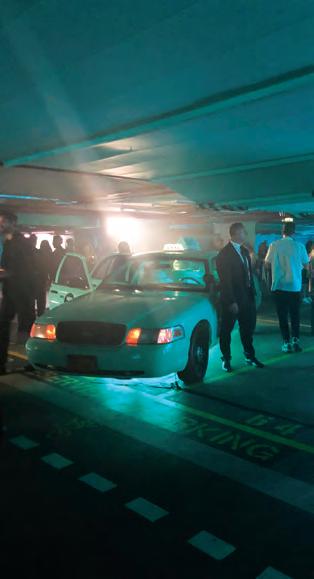
Pop Up News
Preview recent Pop Up news here, and read the full story online at shoppingcentrenews.com.au


Broadway Sydney elevates Indigenous artists and designers for NAIDOC Week
In a year where many Indigenous businesses have been severely impacted by COVID, Broadway Sydney shifted its commercial strength to connect Indigenous designers from across the country with Sydneysiders during NAIDOC Week with an Indigenous designer Pop Up store. Centre Manager, Justine Saltmarsh, said partnering with Indigenous creatives during NAIDOC Week was a great opportunity to support Indigenous businesses and communities in a unique way.
Twenty Indigenous designers from different regions have teamed up to host the Indigenous Collective Pop Up Store. The collection features art, ceramics, clothes, accessories, jewellery, textiles, homewares and much more.
“The Indigenous Collective Pop Up is the first of its kind, providing First Nation designers with the opportunity to step out of the art fair, markets and festival scene,” said Teagan Cowlishaw, National Coordinator, First Nations Fashion Design. “This physical retail platform is instrumental in providing economic development within the Australian industry and allows shoppers to connect with Indigenous communities from across the country through our network of premium Indigenous brands.”


Retail incubator program a win-win for Ripley Town Centre and small business
In a bid to identify retailers with aligned values and goals around sustainability, the team at Ripley Town Centre has focused on attracting local artisans and makers to the quarterly Ripley Providore Market hosted on-site, before incubating and transitioning them through to Pop Up tenancies and even longer-term leases within the centre.
This strategy has seen the successful founding and expansion of EcoCentric, an eco-friendly co-operative stocking locally made sustainable, upcycled and natural products to help tackle the war on waste. Centre Manager, Andrew Quinert, said the retail incubator program was a win-win for not only the centre and its existing retailers, but also local small businesses like EcoCentric that are looking to get a feel for a larger, physical space in a growing community. “The impacts of COVID-19 have been felt right across the retail sector and we’re in a position to offer likeminded businesses that are local or from further afield the opportunity to re-establish themselves,” he said. “Our retail incubator program not only provides space at significantly reduced rates – we also offer substantial marketing support and facilitate regular check-in meetings to set them up for success. We’re passionate about supporting the community and local businesses in the area, and we will be exploring more Pop Up opportunities in the future as part of our retail incubator program.” SCN

